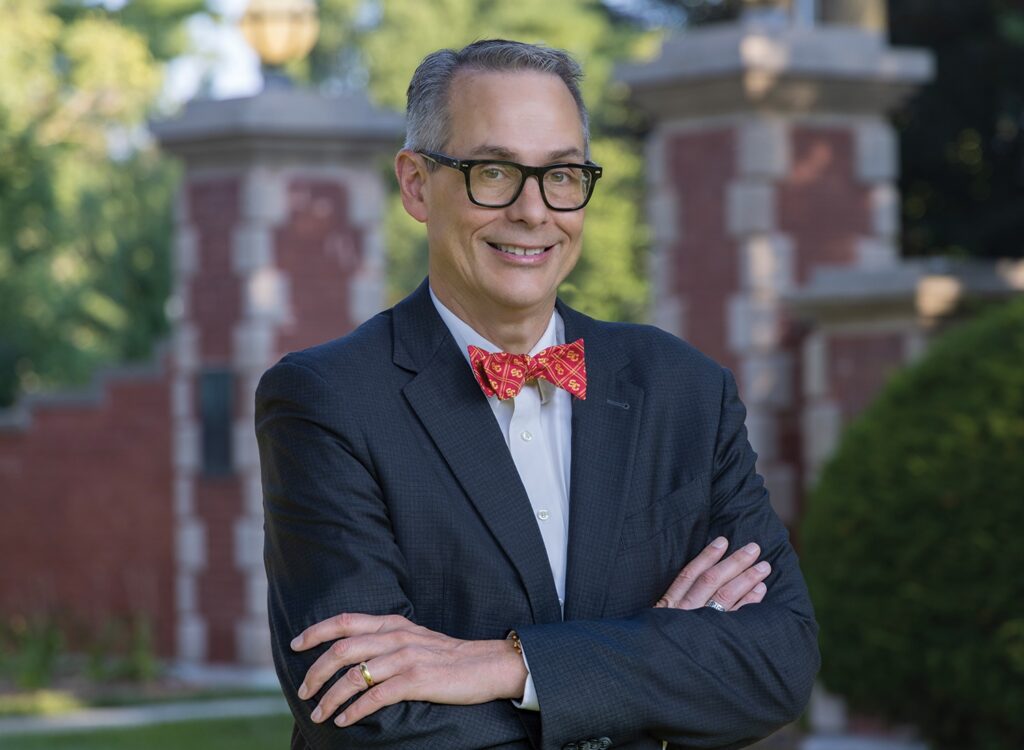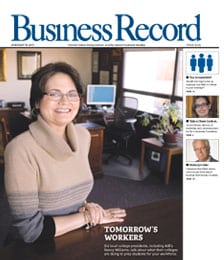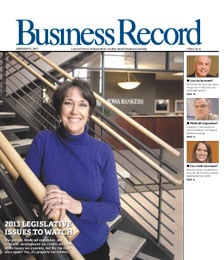Station didn’t have a helicopter, so he bought one for himself

Learning how to fly an airplane was for John McLaughlin what learning how to drive a car is for most people. Both of his parents were pilots, so when he was old enough, he graduated from the passenger seat to the pilot’s, completing his flight training earning his pilot’s license while he was still in high school.
“I remember being 5 years old and going for my first airplane ride,” McLaughlin said. “From then on, I pretty much grew up in the back of an airplane.”
Glidden native McLaughlin, who’s been KCCI television’s chief meteorologist for the past decade, elevated his interest in flying in April when he invested in a $250,000 helicopter and launched a joint venture with fellow KCCI employee Matt Ver Steeg called IowaPilot.com, offering flight instruction, helicopter rides, aerial photography and surveys, and more. The business is not affiliated with KCCI, but the partners are able to employ some of the same talents at both jobs.
“Matt is a camera guy for Channel 8 and one of our computer guys,” McLaughlin said. “He handles the video and photography side of the business, along with taking care of our Web site.”
McLaughlin’s meteorological skills are used in tandem with his flying expertise. He has a mini weather station in his office at Exec 1 Aviation at the Ankeny Regional Airport, allowing him to make sure the conditions are favorable for flying.
“You always have to work around the weather,” McLaughlin said. “A lot of the technology we use at the station can now be called up on my own computer and in the airplane so that we can monitor the strength of the rain and the visibility. Rain is not a big deal for airplanes, but it is for helicopters because it will erode the leading edge of the blade.”
The name recognition he’s gained from his KCCI job helps the business, too. “It’s obviously advantageous when people know that John McLaughlin is their pilot,” he said. “They know that I know the weather and have 4,000 hours of flight time under my belt.”
McLaughlin has been certified as an airplane and helicopter instructor for about five years. What led him to helicopters was the assumption that KCCI would purchase one to compete with “Chopper 13,” rival WHO-TV’s whirlybird. By the time he realized that wasn’t likely to happen, he had already invested in getting licensed, and discovered something unique to love about the experience of piloting a helicopter.
“I enjoy the precision that is involved,” McLaughlin said. “Especially with helicopters, everything has to be done exact. There’s no room for error or sloppiness. It’s a great achievement to be able to do it well.”
McLaughlin ended up putting his helicopter training to use doing commercial work, hiring out his services to give rides to others. After flying traditional two-seat models for a while, he and his dad decided to invest in a four-seat Robinson R-44 to set the IowaPilot.com business apart from all others in the area.
“The R-44 is the most popular helicopter being produced today,” he said. “It’s very sleek and modern, and it’s also the safest. It is known for its reliable components and ability to land safely if the engine goes out unexpectedly.”
But after investing a large sum of money for a 1999 model of the R-44, McLaughlin isn’t expecting any mechanical problems. He keeps it on a strict maintenance schedule, with regular checkups by trained professionals every 100 hours. Helicopters can be purchased for much less than what he and his father paid for theirs, McLaughlin said, but having a new and reliable machine has definite business benefits.
“The maintenance is easier when you’re always flying new equipment, and it makes the passengers feel more comfortable too when they step into a helicopter that looks like it’s brand-new as opposed to one that looks like it was from ‘M*A*S*H,’” he said.
The helicopter, maintenance, fuel and insurance – with an annual premium of $12,000 – make the R-44 expensive to operate. McLaughlin’s most recent calculations show that the helicopter costs add up to $376 per hour. He charges $400 per hour for land surveys and $450 per hour for aerial video and still photography, which make his profit margin slim for the time being. To break even on the investment, he estimates that he needs to fly at least 300 hours per year, and he says the amount of business he and Ver Steeg have done so far has kept them on track with that target.
“We’ve been flying non-stop every weekend for the last six weeks,” McLaughlin said. “We started out strong in the spring in land surveys and getting shots of storm damage. We’ve kept busy with weekend town festivals, where we go and give rides, RAGBRAI and the Farm Progress Show.”
With fall upon them, the IowaPilot.com owners are going to get more creative in finding ways to attract customers and keep the helicopter operating.
“The weekends have been very busy, and they will continue to be through mid-October, when we are down at the Madison County Covered Bridge Festival for the whole weekend,” McLaughlin said. “After that, we’ll start to try to do some of the river valley tours and fall foliage trips. But winter is going to be the true test.”
Even though the helicopter is heated, and is not only completely safe to fly in cold weather, McLaughlin says he knows the business has a challenge ahead of it.
“The challenge is convincing people to fly during the time of the year when it’s not on their mind,” he said. “It hasn’t been too difficult so far, with people wanting to go up on a nice night to take in the sunset or people wanting to survey the land. There’s not going to be a big demand for taking pictures of crops in the middle of winter.”
In December, McLaughlin and Ver Steeg plan to promote IowaPilot.com as a new way to take in the holiday lights. “We’ll sell half-hour bookings for two or three people to fly around and view the lights,” McLaughlin said. They’re also counting on people purchasing helicopter rides as gifts. Gift certificates for half-hour rides go for $250.
When he’s not flying commercially, McLaughlin plans to continue making charitable use of his helicopter. He gets many requests from KCCI weather station schools to drop by and give a lesson about weather and aviation, which has always been something he’s enjoyed doing, he said.
“I always wanted to have the ability to visit schools,” he said. McLaughlin will also likely have youngsters of his own alongside him sometimes when he’s not using the helicopter for business. His two sons, ages 7 and 12, “love to be in the air,” he says. Whether his two kids will end up flying someday is yet to be determined, but if they do, they will have accomplished something pretty impressive, he says.
“There’s not very many people on the planet who can fly helicopters, and there’s even fewer that can be instructors in helicopters,” McLaughlin said. “It’s a personal achievement to be able to do things that are very difficult. It’s kind of like predicting the weather. That’s another complicated business.”
The making of a weatherman
John McLaughlin has always been fascinated by science, and his interests in flying and the weather developed simultaneously, he said. By the time he was in junior high school, he was already predicting the weather for his local newspaper in Glidden. Meteorology at that time, he said, was basically learned by getting “a hold of any resources you could get your hands on.”
McLaughlin said he read all the books he could and ordered weather instruments from science catalogs. Eventually, he had built his own weather station in his bedroom on the family’s Glidden farm. One August day in 1976 sealed his fate as a weatherman, he said. After monitoring the weather instruments in his room, he predicted his first tornado. His mother and two sisters did not believe his prediction, which he backed by citing “the pressure changing and the winds backing out of the southeast” – that is, until they later saw a tornado looming in the distance.
McLaughlin said that first tornado he predicted was the only tornado in Iowa that day, and a point in his life he will always remember. After earning a journalism degree from Iowa State University and working as a reporter for a while, he obtained a meteorology degree from Mississippi State University.






